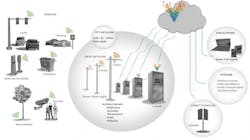The business value of enterprise IoT is based on a premise that there is a huge amount of potential value in the data generated by existing systems (legacy sub-systems, in IoT terms) and newly connected Things (sensor networks, brilliant machines, mobiles, gateways, etc.)…if only it can be unlocked through ubiquitous data availability for apps and analytics to extract new and actionable insights.
For OEMs and system vendors, the focus of the IoT will often be on enabling new products, new services, and an enhanced customer experience. The ability to generate in-operation data from products, access and analyze them remotely (by other devices, a Smartphone app, a cloud service, or others), and generate new insights into product performance, integrity, energy consumption, utilization, etc. gives vendors the ability to more closely align their offerings with their customers’ business needs and add new services (and thus new revenues) to their portfolio. In this way, the IoT can revolutionize the way a required business solution is delivered and dramatically increase user-friendliness, inter-operability and the efficiency of post-sales customer service. At PrismTech we see many OEMs moving quickly from offering stand-alone products to selling connected systems and the valuable data they generate and services they enable. The quest for sustainable competitive advantage (and fear of falling behind) will fund OEM investment in the IoT and provide the RoI projections that executives require to fund new product and system development.
“We already dispelled the myth that interoperability can’t be done in the short term without spending millions. Now, we have three primary goals: create a cost-competitive microgrid, help manufacturers bring interoperable products to market and develop common industry-adopted language to navigate this new territory.” explained Jason Handley, director of Smart Grid Emerging Technology and Operations, Duke Energy.
After successfully demonstrating in real-time how different grid devices could talk to each other, and reducing the
feedback control process from minutes to less than 10 seconds, the energy industry has really started to take notice. This work is also helping address the key issue of intermittent availability of supply when deploying renewables as part of an integrated generation system. Thus users and device OEMs are collaborating and using the Industrial IoT (IIoT) to unlock new value from device data generation, connectivity and inter-operability -- from products to systems.
For End Users, the focus will often be on operational efficiency and the potential for significant productivity gains and cost reduction. With operational assets (devices, machines, people, buildings, street furniture, etc.) producing more real-time data…and new apps, analytics and inter-operability providing the ability to convert them into actionable insights and superior coordination, the scope for operational gains of many percentage points has been indentified in industries as diverse as manufacturing, energy, transportation, healthcare, cities and critical infrastructure. Projected savings driven by superior energy efficiency, resource utilization, staff deployment, capital asset longevity and reduced cycle times will fund End User investment in the IoT and provide the RoI projections that executives require. Already, the City of Nice and its residents are seeing real benefits from the recent Connected Boulevard project there, including improved city mobility. By having real-time access to car parking space availability data via mobile devices, drivers are taking much less time to park and parking income from reduced fraud is up by 35%. This in turn is helping improve traffic flow and has reduced congestion by 30%. Air pollution and noise levels have been reduced by 25%. In the future, better city management will see savings of between 20-80% in areas such as street lighting and waste management, while improving overall environmental quality.
Lastly, and equally for both OEMs and End Users, it would be remiss of me not to mention the oft-overlooked third benefit of the IoT. Less quantifiable perhaps than increased margins, higher market share, superior efficiency or slower asset depreciation, but still very important to senior executives and corporate boards; so what is this third benefit? Clues: less waste, less energy, less pollution, less traffic congestion. Yes, environmental benefits. Harder to calculate a 36 month RoI perhaps, but as the City of Nice example above demonstrates, a significant factor nonetheless, and one that may help an IoT project get funded even in an era of flat corporate IT expenditures and tight public-sector budgets.
So enterprise/industrial IoT does offer new and compelling RoI scenarios (for both vendors and users) in addition to tactical IT/OT/M2M projects. From small proof-of-concept starter projects to enterprise-wide IoT infrastructure upgrades, RoIs are increasingly being found to justify enterprise IoT investment even if some execs are still skeptical about some of the IoT hype. Enterprise IoT investment is not dependent on intangible returns or fear of competitive disadvantage, but on short-term RoIs based on tangible and quantifiable business benefits like new revenues, lower costs or enhanced and sustainable competitive advantage.
So getting started with enterprise IoT today is practical and provides good RoI potential based on unlocking the value in the data produced by legacy and new connected systems and devices. Pick a good data connectivity platform (see www.prismtech.com/vortex) and you’ll have the underlying technology you need to start creating that new value and those compelling RoI analyses.
Learn more about the Connected Boulevard project in Nice, France.
Steve Jennis is the Senior VP of Corporate Development for PrismTech and a member of the Advisory Board and Program Committee for the Smart Industry Conference and Expo. PrismTech is a provider of system solutions for the Internet of Things, the Industrial Internet and advanced wireless communications. Learn more about their Vortex intelligent data-sharing platform at www.prismtech.com/vortex.






